Business & Business Environment: Tesco
VerifiedAdded on 2021/02/20
|9
|2806
|25
AI Summary
Contribute Materials
Your contribution can guide someone’s learning journey. Share your
documents today.
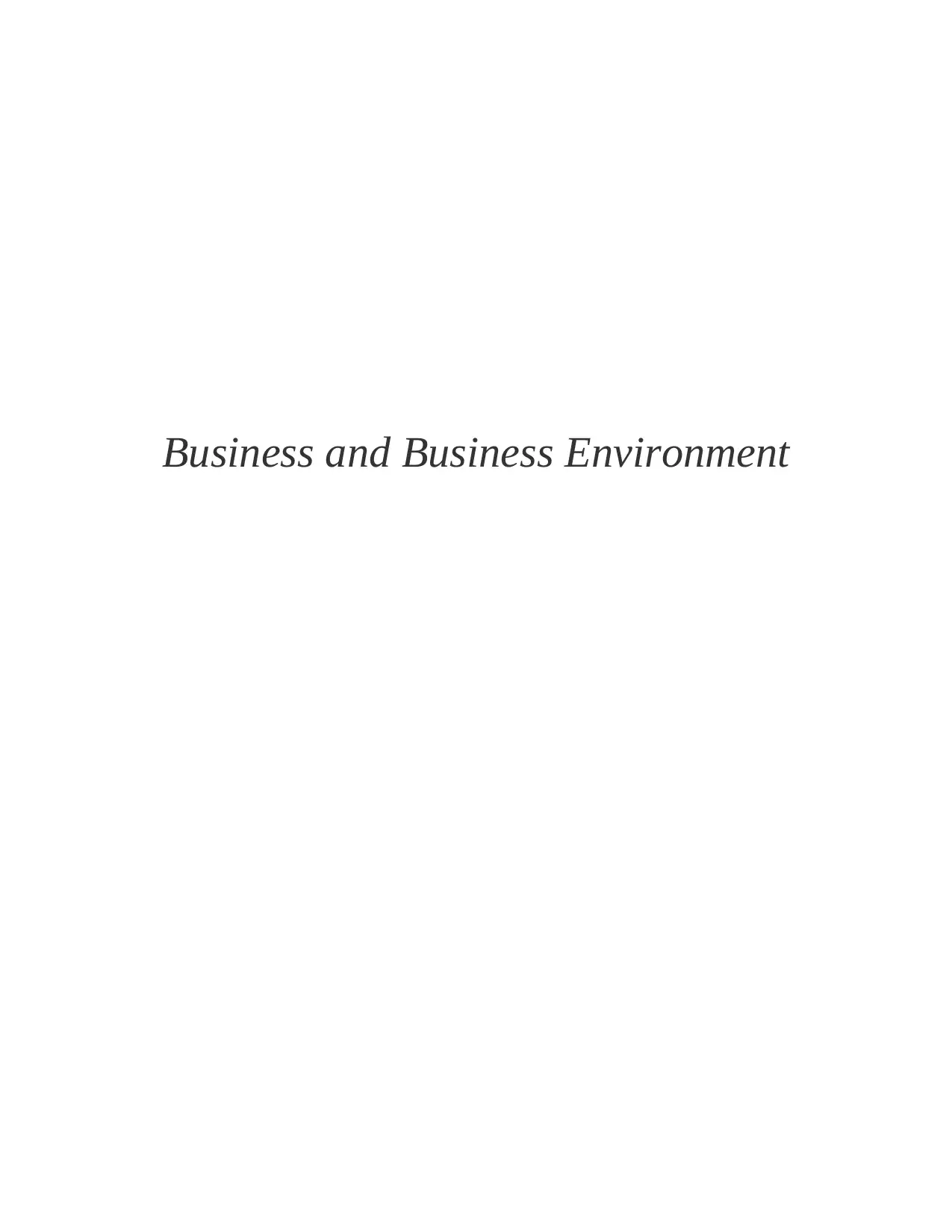
Business and Business Environment
Secure Best Marks with AI Grader
Need help grading? Try our AI Grader for instant feedback on your assignments.
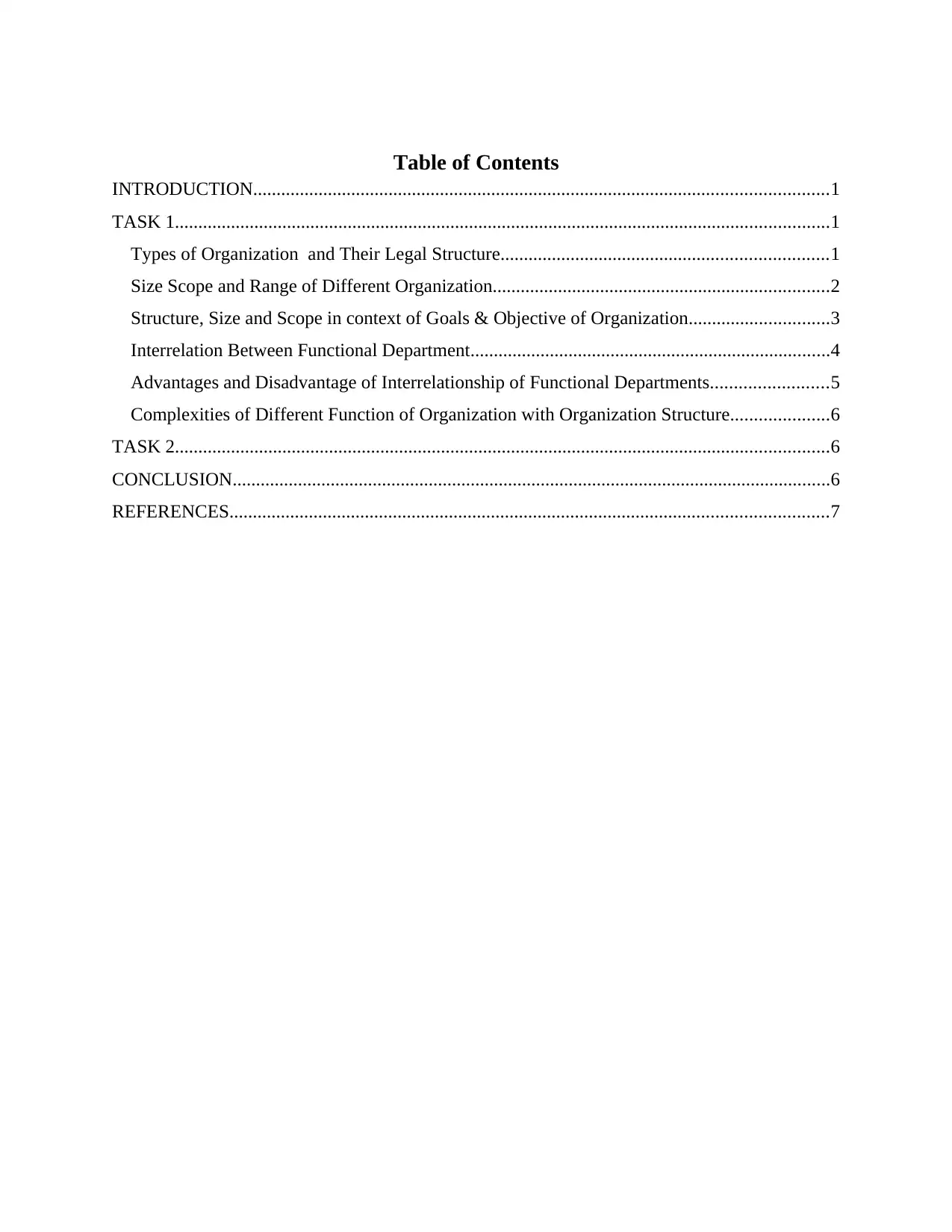
Table of Contents
INTRODUCTION...........................................................................................................................1
TASK 1............................................................................................................................................1
Types of Organization and Their Legal Structure......................................................................1
Size Scope and Range of Different Organization........................................................................2
Structure, Size and Scope in context of Goals & Objective of Organization..............................3
Interrelation Between Functional Department.............................................................................4
Advantages and Disadvantage of Interrelationship of Functional Departments.........................5
Complexities of Different Function of Organization with Organization Structure.....................6
TASK 2............................................................................................................................................6
CONCLUSION................................................................................................................................6
REFERENCES................................................................................................................................7
INTRODUCTION...........................................................................................................................1
TASK 1............................................................................................................................................1
Types of Organization and Their Legal Structure......................................................................1
Size Scope and Range of Different Organization........................................................................2
Structure, Size and Scope in context of Goals & Objective of Organization..............................3
Interrelation Between Functional Department.............................................................................4
Advantages and Disadvantage of Interrelationship of Functional Departments.........................5
Complexities of Different Function of Organization with Organization Structure.....................6
TASK 2............................................................................................................................................6
CONCLUSION................................................................................................................................6
REFERENCES................................................................................................................................7
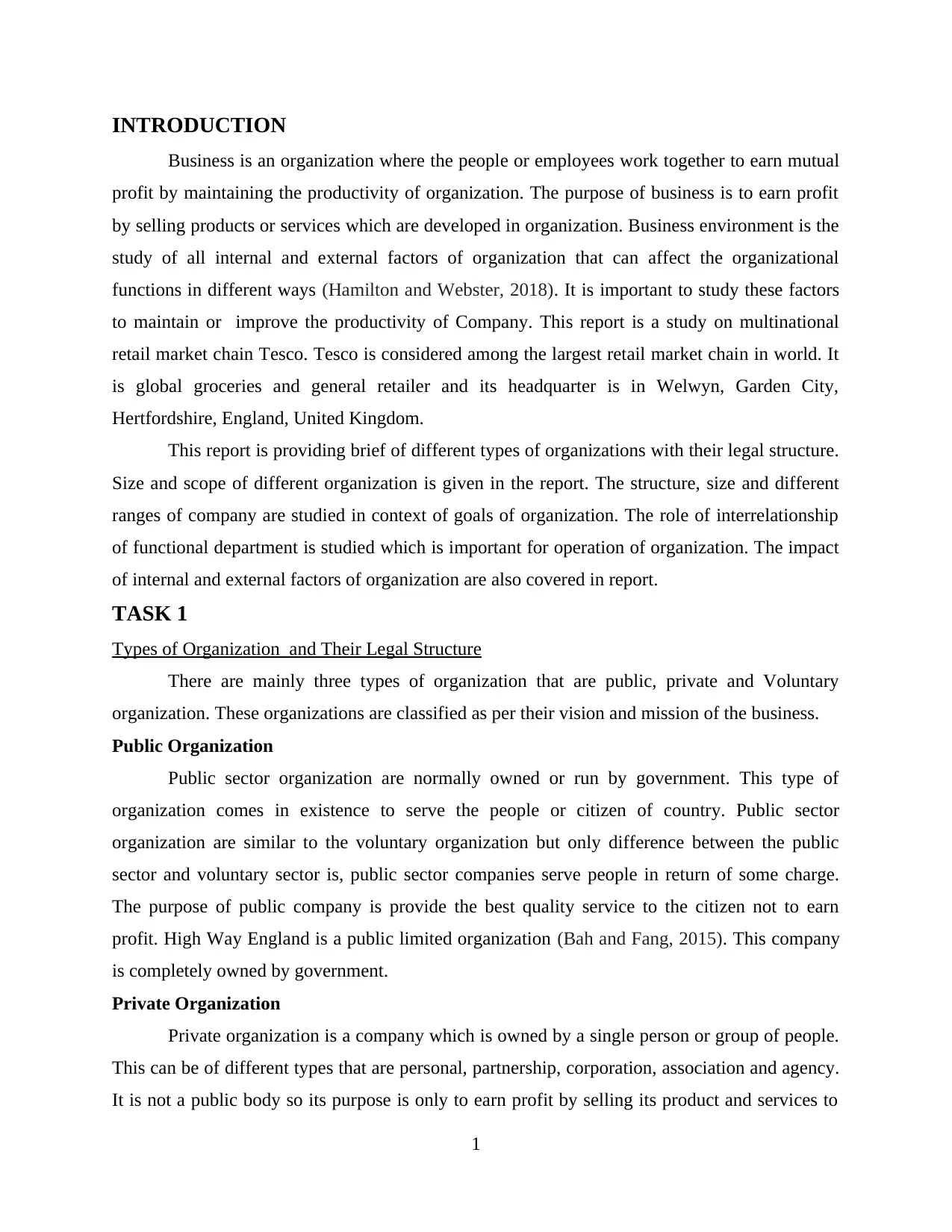
INTRODUCTION
Business is an organization where the people or employees work together to earn mutual
profit by maintaining the productivity of organization. The purpose of business is to earn profit
by selling products or services which are developed in organization. Business environment is the
study of all internal and external factors of organization that can affect the organizational
functions in different ways (Hamilton and Webster, 2018). It is important to study these factors
to maintain or improve the productivity of Company. This report is a study on multinational
retail market chain Tesco. Tesco is considered among the largest retail market chain in world. It
is global groceries and general retailer and its headquarter is in Welwyn, Garden City,
Hertfordshire, England, United Kingdom.
This report is providing brief of different types of organizations with their legal structure.
Size and scope of different organization is given in the report. The structure, size and different
ranges of company are studied in context of goals of organization. The role of interrelationship
of functional department is studied which is important for operation of organization. The impact
of internal and external factors of organization are also covered in report.
TASK 1
Types of Organization and Their Legal Structure
There are mainly three types of organization that are public, private and Voluntary
organization. These organizations are classified as per their vision and mission of the business.
Public Organization
Public sector organization are normally owned or run by government. This type of
organization comes in existence to serve the people or citizen of country. Public sector
organization are similar to the voluntary organization but only difference between the public
sector and voluntary sector is, public sector companies serve people in return of some charge.
The purpose of public company is provide the best quality service to the citizen not to earn
profit. High Way England is a public limited organization (Bah and Fang, 2015). This company
is completely owned by government.
Private Organization
Private organization is a company which is owned by a single person or group of people.
This can be of different types that are personal, partnership, corporation, association and agency.
It is not a public body so its purpose is only to earn profit by selling its product and services to
1
Business is an organization where the people or employees work together to earn mutual
profit by maintaining the productivity of organization. The purpose of business is to earn profit
by selling products or services which are developed in organization. Business environment is the
study of all internal and external factors of organization that can affect the organizational
functions in different ways (Hamilton and Webster, 2018). It is important to study these factors
to maintain or improve the productivity of Company. This report is a study on multinational
retail market chain Tesco. Tesco is considered among the largest retail market chain in world. It
is global groceries and general retailer and its headquarter is in Welwyn, Garden City,
Hertfordshire, England, United Kingdom.
This report is providing brief of different types of organizations with their legal structure.
Size and scope of different organization is given in the report. The structure, size and different
ranges of company are studied in context of goals of organization. The role of interrelationship
of functional department is studied which is important for operation of organization. The impact
of internal and external factors of organization are also covered in report.
TASK 1
Types of Organization and Their Legal Structure
There are mainly three types of organization that are public, private and Voluntary
organization. These organizations are classified as per their vision and mission of the business.
Public Organization
Public sector organization are normally owned or run by government. This type of
organization comes in existence to serve the people or citizen of country. Public sector
organization are similar to the voluntary organization but only difference between the public
sector and voluntary sector is, public sector companies serve people in return of some charge.
The purpose of public company is provide the best quality service to the citizen not to earn
profit. High Way England is a public limited organization (Bah and Fang, 2015). This company
is completely owned by government.
Private Organization
Private organization is a company which is owned by a single person or group of people.
This can be of different types that are personal, partnership, corporation, association and agency.
It is not a public body so its purpose is only to earn profit by selling its product and services to
1
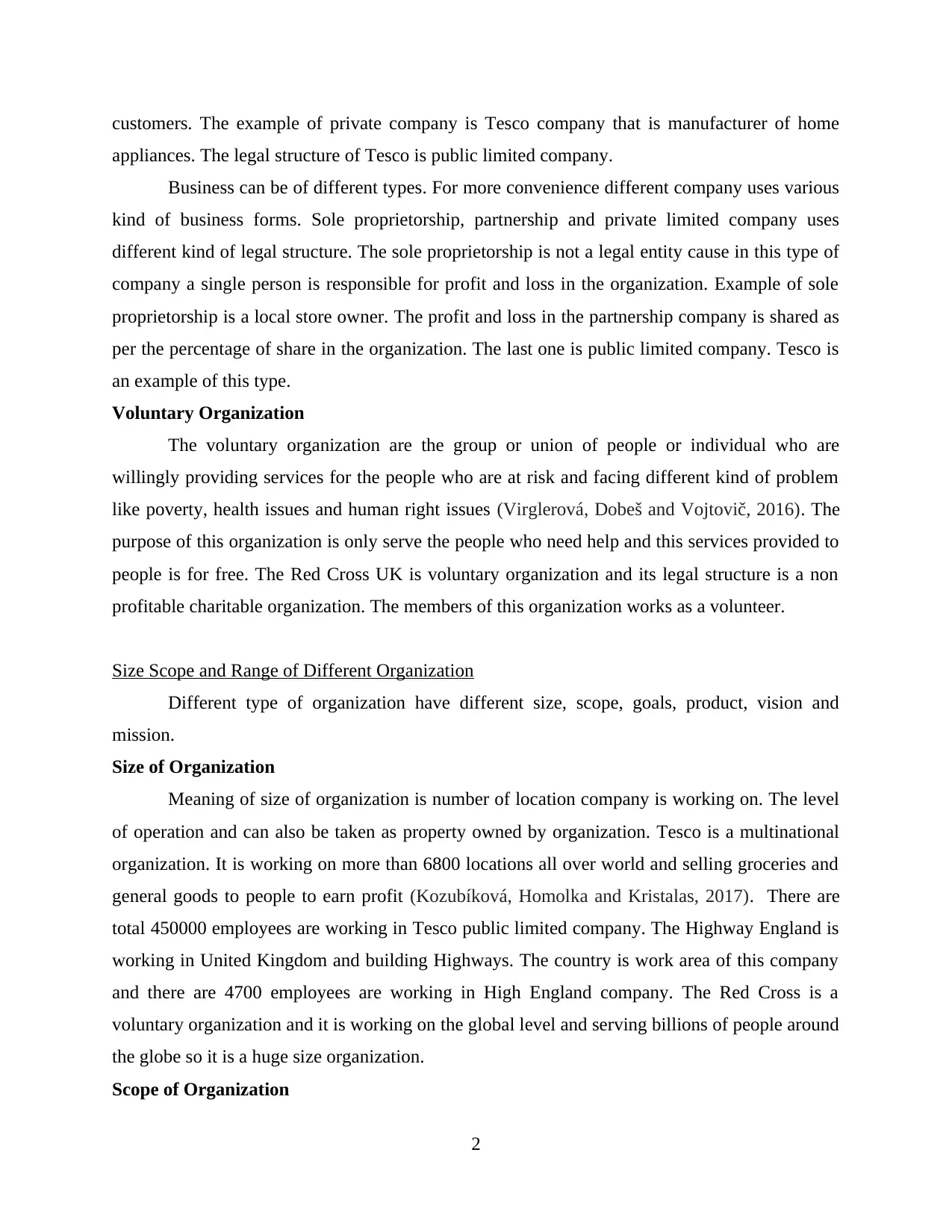
customers. The example of private company is Tesco company that is manufacturer of home
appliances. The legal structure of Tesco is public limited company.
Business can be of different types. For more convenience different company uses various
kind of business forms. Sole proprietorship, partnership and private limited company uses
different kind of legal structure. The sole proprietorship is not a legal entity cause in this type of
company a single person is responsible for profit and loss in the organization. Example of sole
proprietorship is a local store owner. The profit and loss in the partnership company is shared as
per the percentage of share in the organization. The last one is public limited company. Tesco is
an example of this type.
Voluntary Organization
The voluntary organization are the group or union of people or individual who are
willingly providing services for the people who are at risk and facing different kind of problem
like poverty, health issues and human right issues (Virglerová, Dobeš and Vojtovič, 2016). The
purpose of this organization is only serve the people who need help and this services provided to
people is for free. The Red Cross UK is voluntary organization and its legal structure is a non
profitable charitable organization. The members of this organization works as a volunteer.
Size Scope and Range of Different Organization
Different type of organization have different size, scope, goals, product, vision and
mission.
Size of Organization
Meaning of size of organization is number of location company is working on. The level
of operation and can also be taken as property owned by organization. Tesco is a multinational
organization. It is working on more than 6800 locations all over world and selling groceries and
general goods to people to earn profit (Kozubíková, Homolka and Kristalas, 2017). There are
total 450000 employees are working in Tesco public limited company. The Highway England is
working in United Kingdom and building Highways. The country is work area of this company
and there are 4700 employees are working in High England company. The Red Cross is a
voluntary organization and it is working on the global level and serving billions of people around
the globe so it is a huge size organization.
Scope of Organization
2
appliances. The legal structure of Tesco is public limited company.
Business can be of different types. For more convenience different company uses various
kind of business forms. Sole proprietorship, partnership and private limited company uses
different kind of legal structure. The sole proprietorship is not a legal entity cause in this type of
company a single person is responsible for profit and loss in the organization. Example of sole
proprietorship is a local store owner. The profit and loss in the partnership company is shared as
per the percentage of share in the organization. The last one is public limited company. Tesco is
an example of this type.
Voluntary Organization
The voluntary organization are the group or union of people or individual who are
willingly providing services for the people who are at risk and facing different kind of problem
like poverty, health issues and human right issues (Virglerová, Dobeš and Vojtovič, 2016). The
purpose of this organization is only serve the people who need help and this services provided to
people is for free. The Red Cross UK is voluntary organization and its legal structure is a non
profitable charitable organization. The members of this organization works as a volunteer.
Size Scope and Range of Different Organization
Different type of organization have different size, scope, goals, product, vision and
mission.
Size of Organization
Meaning of size of organization is number of location company is working on. The level
of operation and can also be taken as property owned by organization. Tesco is a multinational
organization. It is working on more than 6800 locations all over world and selling groceries and
general goods to people to earn profit (Kozubíková, Homolka and Kristalas, 2017). There are
total 450000 employees are working in Tesco public limited company. The Highway England is
working in United Kingdom and building Highways. The country is work area of this company
and there are 4700 employees are working in High England company. The Red Cross is a
voluntary organization and it is working on the global level and serving billions of people around
the globe so it is a huge size organization.
Scope of Organization
2
Secure Best Marks with AI Grader
Need help grading? Try our AI Grader for instant feedback on your assignments.

The scope of the business is related to the future growth and expansion of company.
Tesco is currently operating mainly in European region and eastern region. It has huge scope to
expand its business to the medium sized cities. The Highway England is a government and
public company so it has only few opportunities to work outside UK. Red cross is already
working on global level only scope Red Cross has is to improve its reach to the people.
Product Of Company
Tesco is selling grocery and other good of daily routine to the customer. Highway
England is Making roads and maintaining in UK. Product of Red Cross is its free services to the
people who are at risk and in danger.
Goals or Mission of Organization
The goal of organization are based on their legal structure. Goal of the Tesco is to
improve its reach to the customer and improve the profit of company (Eling and Schaper, 2017).
Goals of Highway England is to build the best quality and sustainable road in UK and perform
maintenance work to make roads long lasting. Red Cross is serving the people who need help to
keep surviving in world. So goal of Red Cross id to full fill requirements of people who are at
needs.
Vision of organization
The vision statement of Tesco is “We make what matters better, together” the values,
mission and vision of Tesco are interrelated for shaping the identity of company (Uchihira,
Ishimatsu and Inoue, 2016). To ensure the safety of people who are using road for travelling is
vision of Highway England. The vision of Red cross is to inspire, encourage, facilitate and
promote at the times of humanitarian activities by national societies, with a view to prevent and
alleviating human suffering, and thereby contributing to the maintained and promotion of human
dignity and peace in world.
Structure, Size and Scope in context of Goals & Objective of Organization
The structure, size and scope of different organization are related to the goals and
objectives of organization. Structure of organization is based on the needs and goals of
organization. It also defined by the number of employees and legal structure of organization. The
organization structure followed by company affects the operation and different other factors of
organization.
Tesco Organizational Structure,Size and Scope
3
Tesco is currently operating mainly in European region and eastern region. It has huge scope to
expand its business to the medium sized cities. The Highway England is a government and
public company so it has only few opportunities to work outside UK. Red cross is already
working on global level only scope Red Cross has is to improve its reach to the people.
Product Of Company
Tesco is selling grocery and other good of daily routine to the customer. Highway
England is Making roads and maintaining in UK. Product of Red Cross is its free services to the
people who are at risk and in danger.
Goals or Mission of Organization
The goal of organization are based on their legal structure. Goal of the Tesco is to
improve its reach to the customer and improve the profit of company (Eling and Schaper, 2017).
Goals of Highway England is to build the best quality and sustainable road in UK and perform
maintenance work to make roads long lasting. Red Cross is serving the people who need help to
keep surviving in world. So goal of Red Cross id to full fill requirements of people who are at
needs.
Vision of organization
The vision statement of Tesco is “We make what matters better, together” the values,
mission and vision of Tesco are interrelated for shaping the identity of company (Uchihira,
Ishimatsu and Inoue, 2016). To ensure the safety of people who are using road for travelling is
vision of Highway England. The vision of Red cross is to inspire, encourage, facilitate and
promote at the times of humanitarian activities by national societies, with a view to prevent and
alleviating human suffering, and thereby contributing to the maintained and promotion of human
dignity and peace in world.
Structure, Size and Scope in context of Goals & Objective of Organization
The structure, size and scope of different organization are related to the goals and
objectives of organization. Structure of organization is based on the needs and goals of
organization. It also defined by the number of employees and legal structure of organization. The
organization structure followed by company affects the operation and different other factors of
organization.
Tesco Organizational Structure,Size and Scope
3
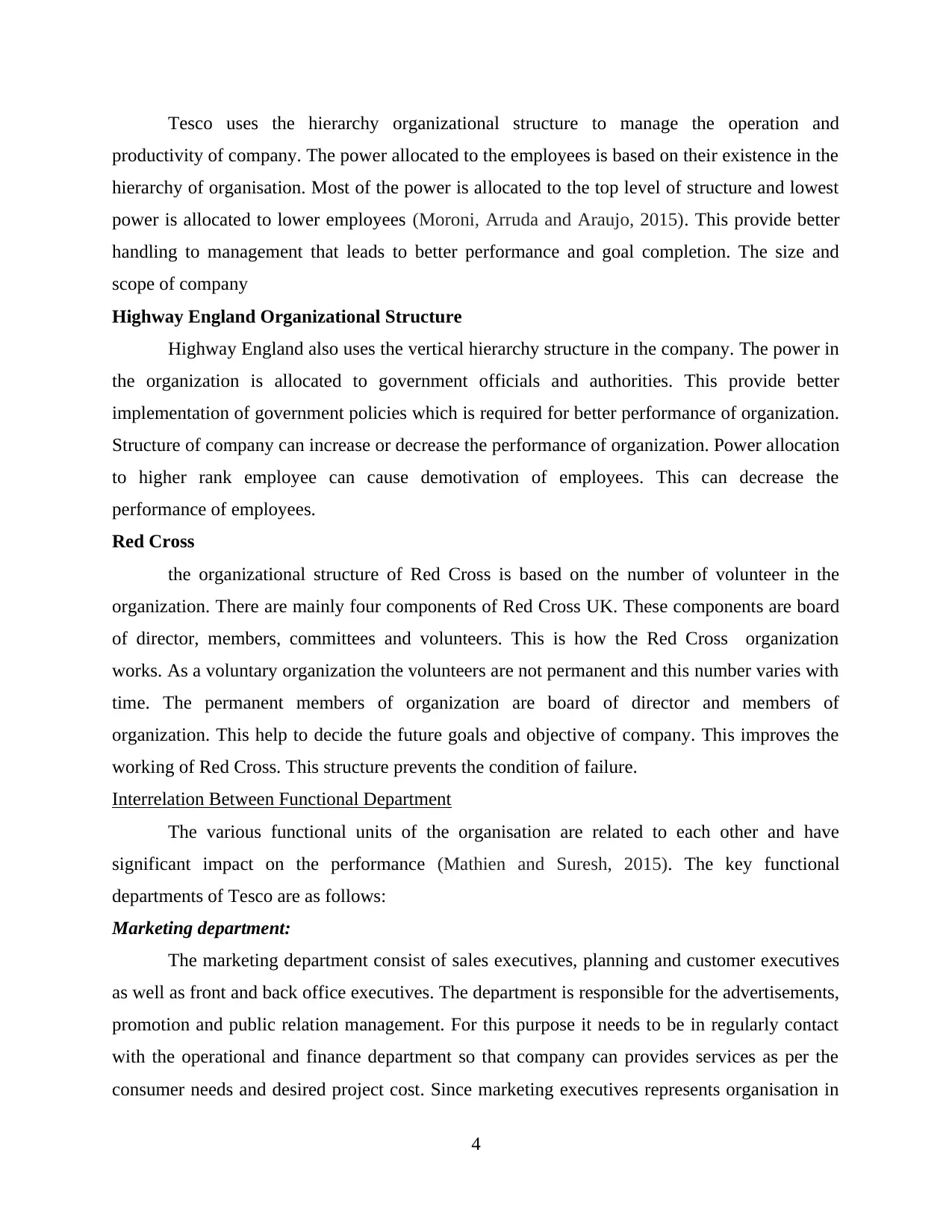
Tesco uses the hierarchy organizational structure to manage the operation and
productivity of company. The power allocated to the employees is based on their existence in the
hierarchy of organisation. Most of the power is allocated to the top level of structure and lowest
power is allocated to lower employees (Moroni, Arruda and Araujo, 2015). This provide better
handling to management that leads to better performance and goal completion. The size and
scope of company
Highway England Organizational Structure
Highway England also uses the vertical hierarchy structure in the company. The power in
the organization is allocated to government officials and authorities. This provide better
implementation of government policies which is required for better performance of organization.
Structure of company can increase or decrease the performance of organization. Power allocation
to higher rank employee can cause demotivation of employees. This can decrease the
performance of employees.
Red Cross
the organizational structure of Red Cross is based on the number of volunteer in the
organization. There are mainly four components of Red Cross UK. These components are board
of director, members, committees and volunteers. This is how the Red Cross organization
works. As a voluntary organization the volunteers are not permanent and this number varies with
time. The permanent members of organization are board of director and members of
organization. This help to decide the future goals and objective of company. This improves the
working of Red Cross. This structure prevents the condition of failure.
Interrelation Between Functional Department
The various functional units of the organisation are related to each other and have
significant impact on the performance (Mathien and Suresh, 2015). The key functional
departments of Tesco are as follows:
Marketing department:
The marketing department consist of sales executives, planning and customer executives
as well as front and back office executives. The department is responsible for the advertisements,
promotion and public relation management. For this purpose it needs to be in regularly contact
with the operational and finance department so that company can provides services as per the
consumer needs and desired project cost. Since marketing executives represents organisation in
4
productivity of company. The power allocated to the employees is based on their existence in the
hierarchy of organisation. Most of the power is allocated to the top level of structure and lowest
power is allocated to lower employees (Moroni, Arruda and Araujo, 2015). This provide better
handling to management that leads to better performance and goal completion. The size and
scope of company
Highway England Organizational Structure
Highway England also uses the vertical hierarchy structure in the company. The power in
the organization is allocated to government officials and authorities. This provide better
implementation of government policies which is required for better performance of organization.
Structure of company can increase or decrease the performance of organization. Power allocation
to higher rank employee can cause demotivation of employees. This can decrease the
performance of employees.
Red Cross
the organizational structure of Red Cross is based on the number of volunteer in the
organization. There are mainly four components of Red Cross UK. These components are board
of director, members, committees and volunteers. This is how the Red Cross organization
works. As a voluntary organization the volunteers are not permanent and this number varies with
time. The permanent members of organization are board of director and members of
organization. This help to decide the future goals and objective of company. This improves the
working of Red Cross. This structure prevents the condition of failure.
Interrelation Between Functional Department
The various functional units of the organisation are related to each other and have
significant impact on the performance (Mathien and Suresh, 2015). The key functional
departments of Tesco are as follows:
Marketing department:
The marketing department consist of sales executives, planning and customer executives
as well as front and back office executives. The department is responsible for the advertisements,
promotion and public relation management. For this purpose it needs to be in regularly contact
with the operational and finance department so that company can provides services as per the
consumer needs and desired project cost. Since marketing executives represents organisation in
4
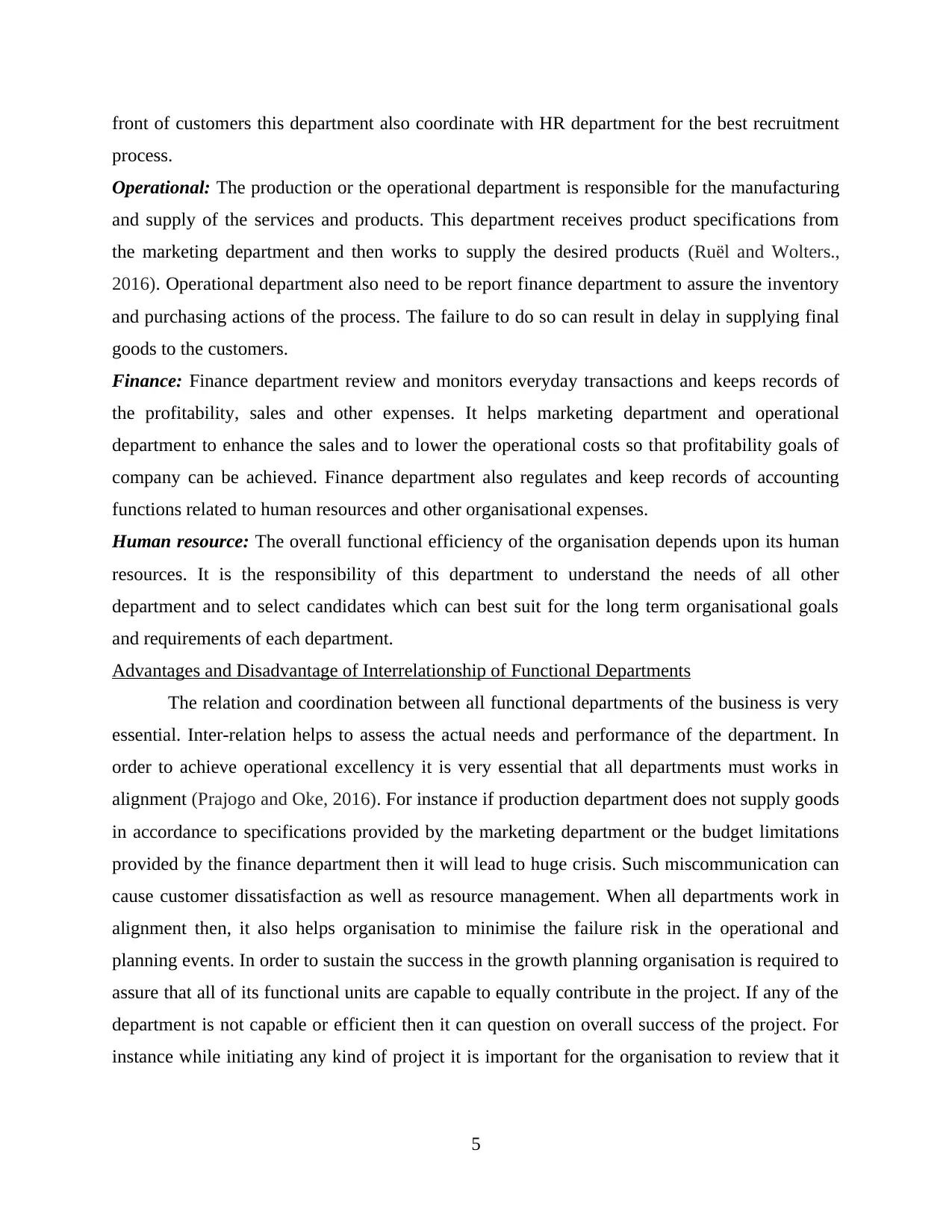
front of customers this department also coordinate with HR department for the best recruitment
process.
Operational: The production or the operational department is responsible for the manufacturing
and supply of the services and products. This department receives product specifications from
the marketing department and then works to supply the desired products (Ruël and Wolters.,
2016). Operational department also need to be report finance department to assure the inventory
and purchasing actions of the process. The failure to do so can result in delay in supplying final
goods to the customers.
Finance: Finance department review and monitors everyday transactions and keeps records of
the profitability, sales and other expenses. It helps marketing department and operational
department to enhance the sales and to lower the operational costs so that profitability goals of
company can be achieved. Finance department also regulates and keep records of accounting
functions related to human resources and other organisational expenses.
Human resource: The overall functional efficiency of the organisation depends upon its human
resources. It is the responsibility of this department to understand the needs of all other
department and to select candidates which can best suit for the long term organisational goals
and requirements of each department.
Advantages and Disadvantage of Interrelationship of Functional Departments
The relation and coordination between all functional departments of the business is very
essential. Inter-relation helps to assess the actual needs and performance of the department. In
order to achieve operational excellency it is very essential that all departments must works in
alignment (Prajogo and Oke, 2016). For instance if production department does not supply goods
in accordance to specifications provided by the marketing department or the budget limitations
provided by the finance department then it will lead to huge crisis. Such miscommunication can
cause customer dissatisfaction as well as resource management. When all departments work in
alignment then, it also helps organisation to minimise the failure risk in the operational and
planning events. In order to sustain the success in the growth planning organisation is required to
assure that all of its functional units are capable to equally contribute in the project. If any of the
department is not capable or efficient then it can question on overall success of the project. For
instance while initiating any kind of project it is important for the organisation to review that it
5
process.
Operational: The production or the operational department is responsible for the manufacturing
and supply of the services and products. This department receives product specifications from
the marketing department and then works to supply the desired products (Ruël and Wolters.,
2016). Operational department also need to be report finance department to assure the inventory
and purchasing actions of the process. The failure to do so can result in delay in supplying final
goods to the customers.
Finance: Finance department review and monitors everyday transactions and keeps records of
the profitability, sales and other expenses. It helps marketing department and operational
department to enhance the sales and to lower the operational costs so that profitability goals of
company can be achieved. Finance department also regulates and keep records of accounting
functions related to human resources and other organisational expenses.
Human resource: The overall functional efficiency of the organisation depends upon its human
resources. It is the responsibility of this department to understand the needs of all other
department and to select candidates which can best suit for the long term organisational goals
and requirements of each department.
Advantages and Disadvantage of Interrelationship of Functional Departments
The relation and coordination between all functional departments of the business is very
essential. Inter-relation helps to assess the actual needs and performance of the department. In
order to achieve operational excellency it is very essential that all departments must works in
alignment (Prajogo and Oke, 2016). For instance if production department does not supply goods
in accordance to specifications provided by the marketing department or the budget limitations
provided by the finance department then it will lead to huge crisis. Such miscommunication can
cause customer dissatisfaction as well as resource management. When all departments work in
alignment then, it also helps organisation to minimise the failure risk in the operational and
planning events. In order to sustain the success in the growth planning organisation is required to
assure that all of its functional units are capable to equally contribute in the project. If any of the
department is not capable or efficient then it can question on overall success of the project. For
instance while initiating any kind of project it is important for the organisation to review that it
5
Paraphrase This Document
Need a fresh take? Get an instant paraphrase of this document with our AI Paraphraser
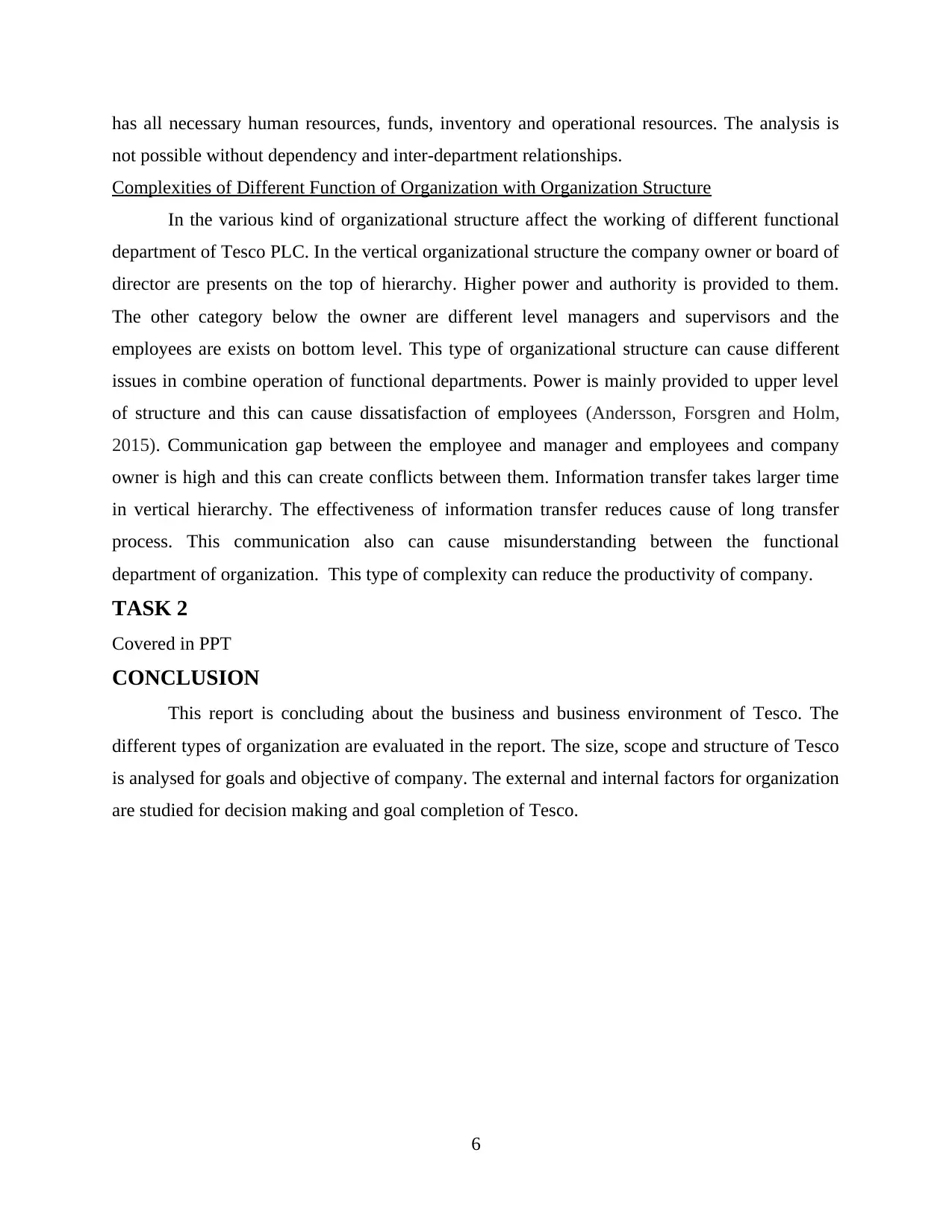
has all necessary human resources, funds, inventory and operational resources. The analysis is
not possible without dependency and inter-department relationships.
Complexities of Different Function of Organization with Organization Structure
In the various kind of organizational structure affect the working of different functional
department of Tesco PLC. In the vertical organizational structure the company owner or board of
director are presents on the top of hierarchy. Higher power and authority is provided to them.
The other category below the owner are different level managers and supervisors and the
employees are exists on bottom level. This type of organizational structure can cause different
issues in combine operation of functional departments. Power is mainly provided to upper level
of structure and this can cause dissatisfaction of employees (Andersson, Forsgren and Holm,
2015). Communication gap between the employee and manager and employees and company
owner is high and this can create conflicts between them. Information transfer takes larger time
in vertical hierarchy. The effectiveness of information transfer reduces cause of long transfer
process. This communication also can cause misunderstanding between the functional
department of organization. This type of complexity can reduce the productivity of company.
TASK 2
Covered in PPT
CONCLUSION
This report is concluding about the business and business environment of Tesco. The
different types of organization are evaluated in the report. The size, scope and structure of Tesco
is analysed for goals and objective of company. The external and internal factors for organization
are studied for decision making and goal completion of Tesco.
6
not possible without dependency and inter-department relationships.
Complexities of Different Function of Organization with Organization Structure
In the various kind of organizational structure affect the working of different functional
department of Tesco PLC. In the vertical organizational structure the company owner or board of
director are presents on the top of hierarchy. Higher power and authority is provided to them.
The other category below the owner are different level managers and supervisors and the
employees are exists on bottom level. This type of organizational structure can cause different
issues in combine operation of functional departments. Power is mainly provided to upper level
of structure and this can cause dissatisfaction of employees (Andersson, Forsgren and Holm,
2015). Communication gap between the employee and manager and employees and company
owner is high and this can create conflicts between them. Information transfer takes larger time
in vertical hierarchy. The effectiveness of information transfer reduces cause of long transfer
process. This communication also can cause misunderstanding between the functional
department of organization. This type of complexity can reduce the productivity of company.
TASK 2
Covered in PPT
CONCLUSION
This report is concluding about the business and business environment of Tesco. The
different types of organization are evaluated in the report. The size, scope and structure of Tesco
is analysed for goals and objective of company. The external and internal factors for organization
are studied for decision making and goal completion of Tesco.
6
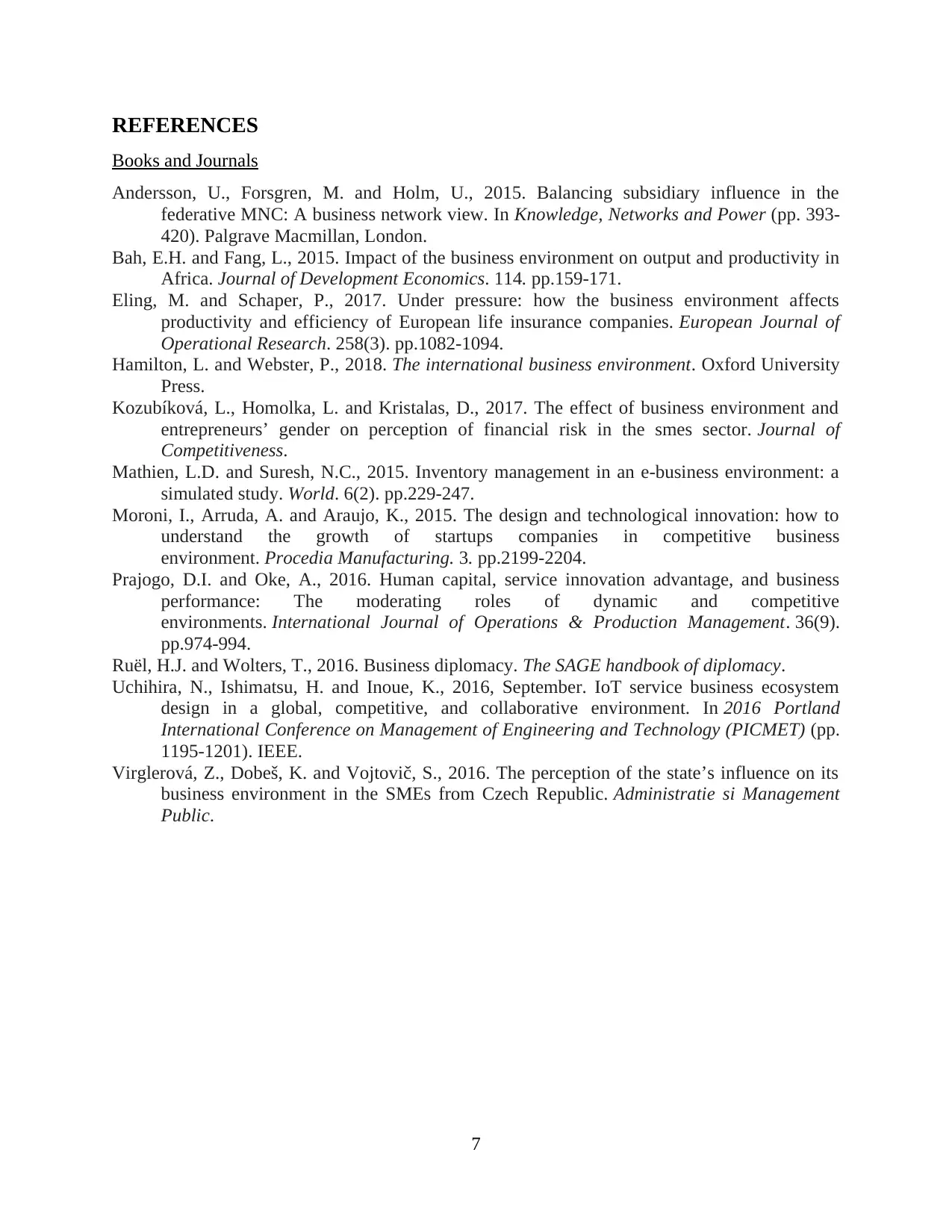
REFERENCES
Books and Journals
Andersson, U., Forsgren, M. and Holm, U., 2015. Balancing subsidiary influence in the
federative MNC: A business network view. In Knowledge, Networks and Power (pp. 393-
420). Palgrave Macmillan, London.
Bah, E.H. and Fang, L., 2015. Impact of the business environment on output and productivity in
Africa. Journal of Development Economics. 114. pp.159-171.
Eling, M. and Schaper, P., 2017. Under pressure: how the business environment affects
productivity and efficiency of European life insurance companies. European Journal of
Operational Research. 258(3). pp.1082-1094.
Hamilton, L. and Webster, P., 2018. The international business environment. Oxford University
Press.
Kozubíková, L., Homolka, L. and Kristalas, D., 2017. The effect of business environment and
entrepreneurs’ gender on perception of financial risk in the smes sector. Journal of
Competitiveness.
Mathien, L.D. and Suresh, N.C., 2015. Inventory management in an e-business environment: a
simulated study. World. 6(2). pp.229-247.
Moroni, I., Arruda, A. and Araujo, K., 2015. The design and technological innovation: how to
understand the growth of startups companies in competitive business
environment. Procedia Manufacturing. 3. pp.2199-2204.
Prajogo, D.I. and Oke, A., 2016. Human capital, service innovation advantage, and business
performance: The moderating roles of dynamic and competitive
environments. International Journal of Operations & Production Management. 36(9).
pp.974-994.
Ruël, H.J. and Wolters, T., 2016. Business diplomacy. The SAGE handbook of diplomacy.
Uchihira, N., Ishimatsu, H. and Inoue, K., 2016, September. IoT service business ecosystem
design in a global, competitive, and collaborative environment. In 2016 Portland
International Conference on Management of Engineering and Technology (PICMET) (pp.
1195-1201). IEEE.
Virglerová, Z., Dobeš, K. and Vojtovič, S., 2016. The perception of the state’s influence on its
business environment in the SMEs from Czech Republic. Administratie si Management
Public.
7
Books and Journals
Andersson, U., Forsgren, M. and Holm, U., 2015. Balancing subsidiary influence in the
federative MNC: A business network view. In Knowledge, Networks and Power (pp. 393-
420). Palgrave Macmillan, London.
Bah, E.H. and Fang, L., 2015. Impact of the business environment on output and productivity in
Africa. Journal of Development Economics. 114. pp.159-171.
Eling, M. and Schaper, P., 2017. Under pressure: how the business environment affects
productivity and efficiency of European life insurance companies. European Journal of
Operational Research. 258(3). pp.1082-1094.
Hamilton, L. and Webster, P., 2018. The international business environment. Oxford University
Press.
Kozubíková, L., Homolka, L. and Kristalas, D., 2017. The effect of business environment and
entrepreneurs’ gender on perception of financial risk in the smes sector. Journal of
Competitiveness.
Mathien, L.D. and Suresh, N.C., 2015. Inventory management in an e-business environment: a
simulated study. World. 6(2). pp.229-247.
Moroni, I., Arruda, A. and Araujo, K., 2015. The design and technological innovation: how to
understand the growth of startups companies in competitive business
environment. Procedia Manufacturing. 3. pp.2199-2204.
Prajogo, D.I. and Oke, A., 2016. Human capital, service innovation advantage, and business
performance: The moderating roles of dynamic and competitive
environments. International Journal of Operations & Production Management. 36(9).
pp.974-994.
Ruël, H.J. and Wolters, T., 2016. Business diplomacy. The SAGE handbook of diplomacy.
Uchihira, N., Ishimatsu, H. and Inoue, K., 2016, September. IoT service business ecosystem
design in a global, competitive, and collaborative environment. In 2016 Portland
International Conference on Management of Engineering and Technology (PICMET) (pp.
1195-1201). IEEE.
Virglerová, Z., Dobeš, K. and Vojtovič, S., 2016. The perception of the state’s influence on its
business environment in the SMEs from Czech Republic. Administratie si Management
Public.
7
1 out of 9
Related Documents
Your All-in-One AI-Powered Toolkit for Academic Success.
+13062052269
info@desklib.com
Available 24*7 on WhatsApp / Email
![[object Object]](/_next/static/media/star-bottom.7253800d.svg)
Unlock your academic potential
© 2024 | Zucol Services PVT LTD | All rights reserved.





